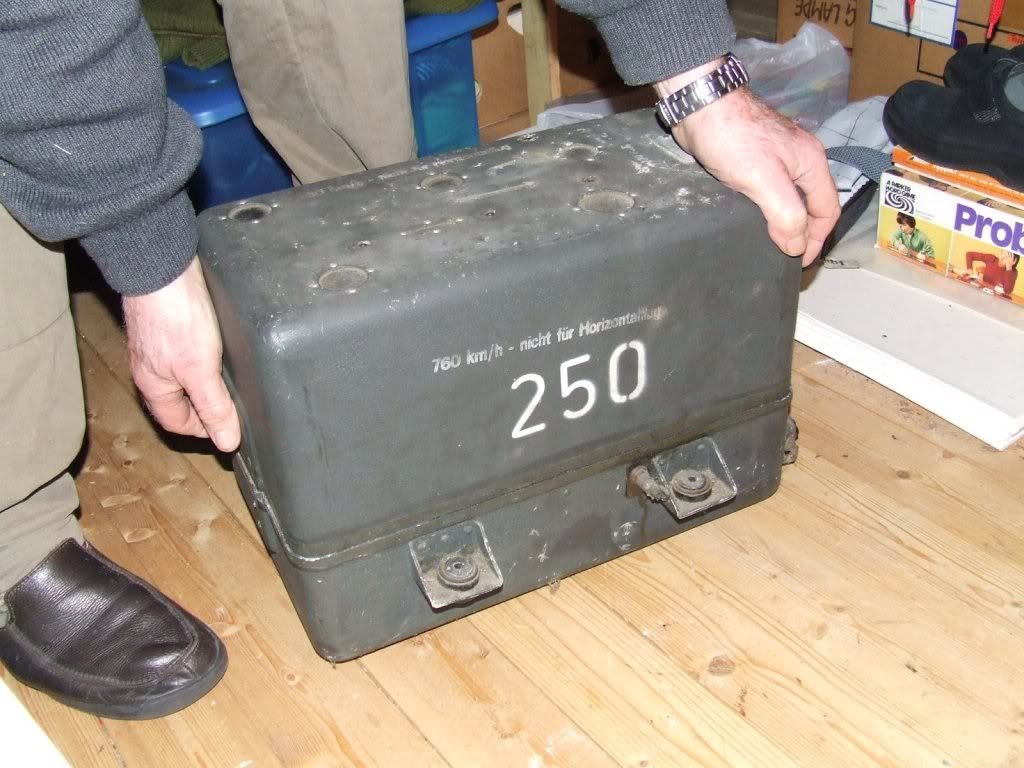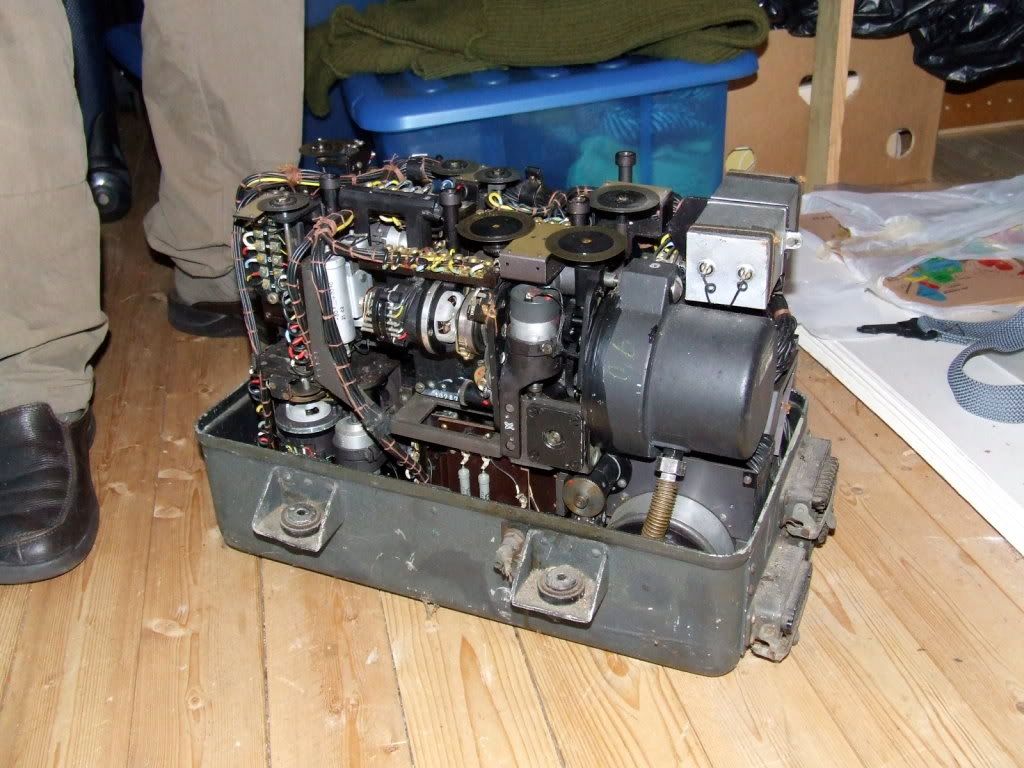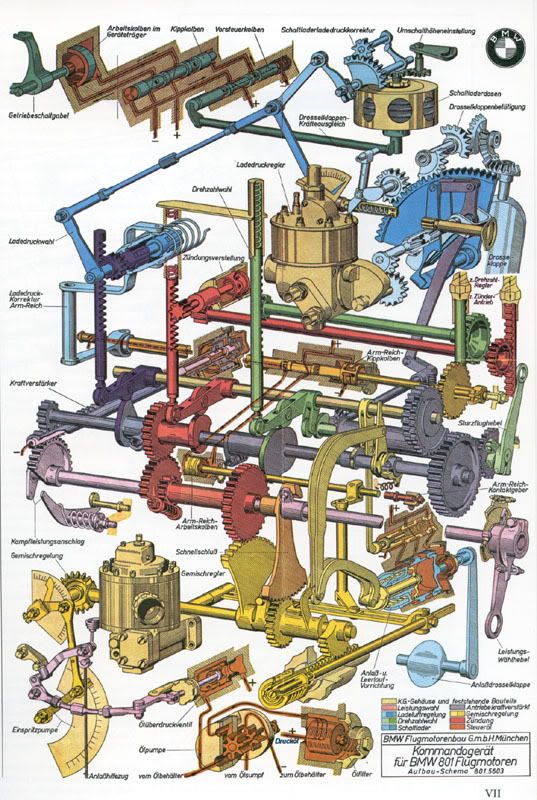Page 1 sur 1
Système ressource automatique Ju87
Publié : lun. juin 14, 2010 9:45 pm
par SpruceGoose
Bonsoir
Le Ju87 Stuka possédait un système de ressource automatique initié par le larguage de sa bombe (après le piqué).
Il n'y avait pas d'intervention de la part du pilote.
La ressource était calibrée avec précision à exactement 6g (à confirmer ou infirmer svp).
Pourriez-vous me fournir des explications précises (texte et/ou schéma) sur le fonctionnement du système (réputé très fiable) i.e mécanisme, cinématique...
Je me remets un peu dans
La Bataille d'Angleterre (publication 2010).
http://www.play.com/Books/Books/4-/1434 ... duct.html#
Thanks !
* * *
Publié : lun. juin 14, 2010 9:56 pm
par Scrat
C'était pas un gros ressort de rappel libéré par le largage de la bombe qui tirait le manche à balai vers l'arrière, avec effectivement une accélération de 6 G en ressource ???
Publié : lun. juin 14, 2010 10:01 pm
par SpruceGoose
Il est quand même intéressant d'avoir le mécanisme en détail, car obtenir exactement 6g (ou xxg), ça relève d'une précision qui me laisse admiratif.
J'ai trouvé des sites qui parlaient d'une action sur le trim de profondeur. Aucune précision cependant...
* * *
Publié : lun. juin 14, 2010 10:54 pm
par sam7gainful
Salut,
Si je ne me trompe pas, le système est plus complexe que cela car si mes souvenir sont exact il ne s'agit pas simplement d'un système de ressource mais gérant également le larguage (déclenchement altimètrique) et la rétraction des freins de piqué. je vais fouiner un peu je dois avoir de la doc qui traine là dessus.
A plus V.
Publié : lun. juin 14, 2010 11:23 pm
par sam7gainful
Publié : mar. juin 15, 2010 9:11 am
par warbird2000
Dans un squadron signal, on indique que après amélioration le système se basait sur l'altimètre et utilisait par défaut la valeur de 1475 pieds .
Le pilote pouvait toujours contourner le mécanisme en exercant une forte traction sur la manche ( over-ridden , strong pull )
Publié : mar. juin 15, 2010 10:07 am
par Warlordimi
SpruceGoose a écrit :Bonsoir
Le Ju87 Stuka possédait un système de ressource automatique initié par le larguage de sa bombe (après le piqué).
Il n'y avait pas d'intervention de la part du pilote.
La ressource était calibrée avec précision à exactement 6g (à confirmer ou infirmer svp)[/url]
J'ai un schéma qui le montre tirant à 12G dans certains cas!
Mais ce n'est qu'un schéma montrant la ressource, pas du mécanisme!
EDIT:
Extraordinaire, je retrouve mon propre scan sur la toile via gougoule...

Sinon, j'ai ça aussi:
Hello! A typical dive-bombing attack by a Ju-87 was as follows: Before the dive starts, the pilot switches on his reflector sight, trimmed the aircraft for dive, set the pullout altitude on the contact altimeter. The radiator flaps were then closed, and engine speed cut back, and opened the ventilation air supply to the windscreen(so it did not fog up). Next the dive brakes were opened and the dive started at 15,000 feet at an angle of 80 degrees. The pilot using his small window set in the floor, judged when to begin the dive. The dive took 30 seconds to reach 3,000 feet, the normal height against defended targets. During the dive the pilot had full control of the aircraft, to keep the target in sight. Four seconds before the pre-selected altitude is reached(3,000ft), an alarm horn sounded, and when it
stopped, the pilot pressed a button on the control stick. This early form of
auto-pilot, pulled the plane out of the dive, and released the bombs. After
pullout, the pilot regained control of the aircraft, pulled up the dive brakes, opened the radiator flaps, trimmed aircraft for level flight, and opened the throttle. The maximum speed during the dive was 350mph.
Cheers brustcan
Venant de Axis History Forum!
Publié : mar. juin 15, 2010 11:39 am
par warbird2000
Trouvé ici des photos du mécanisme
http://forum.axishistory.com/viewtopic. ... 9&t=149604


My family owns the Ju-87 Stuka Dive Recovery Unit (DRU, which is our own unofficial monicker for the instrument/device or alternatively called "junk/sewing machine" ) of which ‘Furyman’ posted photos.
Referring to the markings visible in the first photo: The implication of "nicht fur Horizontalflug" ought to be clear. I believe “760km/h” is the max airspeed to which the instrument is calibrated to be accurate. I believe “250” is the moment arm the unit’s mass imposes around the aircraft’s CG for weight & balance purposes.
The Stuka's DRU is an electro-mechanical device that contains an internal altimeter, a device to measure G-load, various potentiometers, rheostats, plus power & signal wiring. Input is mechanical. All signal output is electrical. The unit has a few inputs which I have not fully explored yet. But I know one is the setting for barometric pressure on the internal altimeter, and another is setting for pull-out altitude. The electrical output signal of the unit controls servosoperating the Stuka’s control surfaces to bring about or maintain the recovery from a dive within safe limits. I haven’t confirmed whether the unit was truly automatic in that it INITIATES the recovery INDEPENDENT of pilot action. Or if bomb release or a pilot’s toggling of a switch was necessary to activate the unit’s dive recovery assist functions. Perhaps the DRU could be set to be triggered by any of these 3 or more options?
The DRU’s purpose is to prevent the aircrew and aircraft from destruction caused by impact with terrain or excessive G-force. It achieved this by affecting pull-out by movement of the controls while assisting to limit the G’s placed on the airframe.
Thus, it is very likely a DRU could be operated without bomb-release. But recovery from a dive WITHOUT dropping the bombload would have different flight dynamics - and require a higher minimum recovery altitude. This would need to be anticipated by a Stuka pilot and gunner and might be the reason different sources quote different minimum operational altitudes. [Sources vary between 900m and 450m AGL]. Or these may be the difference between operational realities and a theoretical minimum.
Sources also vary in their descriptions of how DRU’s were set up and operated during a mission. However the DRU undoubtedly needs to be fed two critical pieces of information: barometric pressure allowing the internal altimeter to be accurate, and the minimum “pull-up” altitude from which the aircraft needs to recover to avoid impacting terrain. According to one source it was Luftwaffe procedure to establish the minimum altitude before a mission. One source stated the altitude information was input into the unit in flight by the rear gunner, minutes before the dive commenced. This would offer mission flexibility, so an alternate target could be selected by the pilot with the gunner verifying the ground elevation on his charts and set the new minimum altitude in the DRU accordingly.
Publié : mar. juin 15, 2010 12:20 pm
par Warlordimi
Incroyable!!!!

Merci Warbird!!!
Sinon, venant de LEMB (je linke pas, faut être inscrit anyway)...
Clint Mitchell a écrit :
Junkers Ju87 Diving procedure: Flying at 4,600 m (15,000 ft), the pilot located his target through a bomb-sight window in the cockpit floor. The pilot moved the dive lever to the rear, limiting the "throw" of the control column. The dive brakes were activated automatically, set the trim tabs, retarding his throttle, and closing the coolant flaps. The aircraft then rolled 180°, automatically nosing the aircraft into a dive. Red tabs protruded from the upper surfaces of the wing as a visual indicator to the pilot that, in case of a g-induced black-out, the automatic dive recovery system would be activated. The Ju87 Stuka dived at a 60-90° angle, holding a constant speed of 500-600 km/h (350-370 mph) due to dive-brake deployment, which increased the accuracy of the Ju87's aim. When the aircraft was reasonably close to the target, a light on the contact altimeter came on to indicate the bomb-release point, usually at a minimum height of 450m (1,500ft). The pilot released the bomb and initiated the automatic pull-out mechanism by depressing a knob on the control column. An elongated U-shaped crutch located under the fuselage swung the bomb out of the way of the propeller, and the aircraft automatically began a 6 g pull out. Once the nose was above the horizon, dive brakes were retracted, the throttle was opened, and the propeller was set to climb. The pilot regained control and resumed normal flight. The coolant flaps had to be reopened quickly to prevent overheating. Physical stress on the crew was severe. Human beings suffering more than 5 g forces in a seated position will suffer vision impairment in the form of a grey veil known to the Stuka pilots as "seeing stars". They lose vision while remaining conscious] Source: Wikipedia
Source Hope this helps? 
Publié : jeu. juin 17, 2010 10:30 am
par kreelin
Incroyable en effet.... Je serais curieux de savoir quel autre merveille de ce genre les allemands avaient dans leurs autres zincs

Publié : jeu. juin 17, 2010 11:41 am
par Warlordimi
Publié : jeu. juin 17, 2010 11:56 am
par TOPOLO
Croire que l'automatisme et les asservissement sont "nés" avec les FLCS /CdVE est une erreur assez commune...
Il y a des mécanismes d'assistance / stabilisation / couplage sur les commandes avion et moteur depuis la nuit de temps (le Kommandogerät est dasn l'esprit assez proche d'un FADEC)
C'est une peu comme croire que l'on peut simuler le comportement des avions des 60's en pensant que les commandes pilotent directement les surfaces de contrôles.

Nos lointains ancêtres (ceux d'avant le disco) avaient quand même quelques vagues notions de technologie

(et eux ils n'implémentatit pas ça à coup de ligne de code, l'analogique ça avait une autre gueule)
Publié : jeu. juin 17, 2010 12:04 pm
par Warlordimi
Faut voir la gueule de l'Halberstadt D17 au musée de Bruxelles avec son huile moteur minérale qui suinte encore 90 ans après son dernier vol et son pilote auto mécanique à crémaillère!
Publié : jeu. juin 17, 2010 12:50 pm
par tom gun
Warlordimi a écrit :
J'ai un schéma qui le montre tirant à 12G dans certains cas!
t'es sur que la structure (et le pilote) résistaient à cette accélération.
Cela me paraît un peu beaucoup pour les avions de la WW2 ainsi que pour les pilotes qui n'avaient je crois pas de pantalons anti-G.
++
Publié : jeu. juin 17, 2010 2:43 pm
par Warlordimi
C'est pour ça que l'appareil volait tout seul dirigé par le bidule précité en haut du post!
12G en termes de résistance structurelle ne m'étonnes absolument pas. Ce qui arrachait les ailes des appareils de l'époque, c'était la vitesse plus que les ressources qui, comme tu le dis, n'étaient de toute façon pas prévues pour être soutenues par les pilotes!
Publié : jeu. juin 17, 2010 2:50 pm
par kreelin
TOPOLO a écrit :Croire que l'automatisme et les asservissement sont "nés" avec les FLCS /CdVE est une erreur assez commune...
J'avoue que je n'y avais jamais pensé

... Au même titre qu'il n'y a pas si longtemps que cela, je ne savais pas que les ricains utilisaient déjà des bombes à guidage laser dans les années 70

Publié : jeu. juin 17, 2010 3:01 pm
par LUSO 83
kreelin a écrit :.......... je ne savais pas que les ricains utilisaient déjà des bombes à guidage laser dans les années 70

Ah bon???Vietnam pourtant!!o_O
http://fr.wikipedia.org/wiki/Paveway
meme si pas toujours fiable le Wiki!!
Publié : jeu. juin 17, 2010 5:13 pm
par Gaston
Au sujet des Ju-87... il n'y avait pas eu un accident lors d'un exercice, juste avant la guerre, qui avait entraîné la destruction complète d'une escadrille ??? altitude de ressource trop basse avec mauvaise visibilité, je crois...
Publié : jeu. juin 17, 2010 5:36 pm
par Rob1
Si si, utilisé dans la campagne aérienne sur la fin de la guerre vers 1972. Avec notamment 15 bombes qui ont détruit un pont qui avait résisté à des centaines d'attaques aériennes. (Quoique... il y avait un mix de bombes laser et électro-optiques, faudrait que je vérifie.)
Il y a même eu des essais de largage de bombes par un drone Ryan Firebee, années 70 !
Publié : jeu. juin 17, 2010 5:41 pm
par Warlordimi
Tout à fait. Le "désastre de Neuhammer", 15/08/1939...
Double couche nuageuse la seconde apparaissant au sortir de la première et non signalé par le sol!
On the 15.8.1939 two Stuka-groups (Ju 87), I./St.G.76 led by Hauptmann Sigel and I./St.G.2"Immelmann" under Hauptmann Hitschold, were to demonstrate divebomber attacks. Present on the ground at Neuhammer were Generals from Heer and Luftwaffe, von Manstein, von Richthofen, Sperrle and Loerzer.
Over Neuhammer it was 7/10 cloudy over 900 meter, underneath clear. But groundfog came on suddenly, this fact was not communicated to the Gruppe. Sigel with his I./St.G.76, started their dive through the clouds. At the last moment Sigel recognized the danger, warned the rest immediately on the radio, and just got away himself with a ground close shave.
For the rest it was too late...13 Stukas with 26 young pilots and observers crashed into the ground, no survivors.
The Immelmann Gruppe recognized the fog in time and broke off.
Publié : jeu. juin 17, 2010 6:28 pm
par LUSO 83
Rob1 a écrit :Si si, utilisé dans la campagne aérienne sur la fin de la guerre vers 1972. Avec notamment 15 bombes qui ont détruit un pont qui avait résisté à des centaines d'attaques aériennes. (Quoique... il y avait un mix de bombes laser et électro-optiques, faudrait que je vérifie.)
Il y a même eu des essais de largage de bombes par un drone Ryan Firebee, années 70 !
Rob c'est dans ton sens qu'il fallait lire ma réponse,pour preuve,le
Pont Paul Doumer je crois non??:Jumpy:

Je m'étonnais juste que Kreelin ne le sache pas!!
16 F4 lançèrent 29 projectiles guidés contre l'ouvrage. Plusieurs coups au but détruisirent une travée et en endommagèrent plusieurs autres.
Vingt-quatre heures plus tard, quelques appareils retournèrent sur le site et obtinrent 8 nouveaux coups au but. Trois autres travées furent sérieusement endommagées et le pont devint inutilisable.
Aucune perte U.S. ne fut déplorée.
Publié : jeu. juin 17, 2010 10:28 pm
par SpruceGoose
Merci pour les réponses !
Par contre il est dommage qu'on ne trouve nulle part un schéma (éclaté) de tous le mécanisme, depuis le boîtier de commande DRU (Merci Warbird 2000) juqu'aux gouvernes.
Je serais curieux de voir les servo-moteurs commandés par le DRU, leur liaison avec les gouvernes, le mécanisme d'embrayage/débrayage, le dispositif de limitation en g, comment il est régulé, comment il rediminue le g une fois que l'avion remonte, les dispositifs d'amortissement (sinusoïde amortie des régulateurs) etc, etc, etc...
Remarquable tout de même pour l'époque.
* * *






